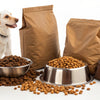Is Kibble or Canned Food Better for Dogs? A Comprehensive Guide for Pet Owners
- Houndsy
Table of Contents
- Introduction
- Understanding the Basics: What Are Kibble and Canned Food?
- Nutritional Considerations: What’s Inside the Bowl?
- The Pros and Cons: Kibble vs. Canned Food
- Mixing Kibble and Canned Food: The Best of Both Worlds
- Enhancing Your Feeding Experience with Houndsy
- Conclusion
Introduction
Did you know that approximately 75% of dog owners struggle to choose the right food for their furry companions? With a staggering variety of dog food options available, from kibble to canned varieties, it’s understandable that many pet parents find themselves overwhelmed. The choice between dry and wet dog food is not merely a matter of preference; it can significantly affect your dog's health, well-being, and happiness.
In this blog post, we will explore the differences between kibble and canned food, examining their respective benefits and drawbacks. By the end, you will have a clearer understanding of which option might be best for your dog, whether you should consider mixing the two, and how our innovative Houndsy Kibble Dispenser can enhance your feeding routine.
We will cover the nutritional aspects, convenience factors, palatability, and potential health implications associated with both types of dog food. So, grab a cup of coffee, and let’s dive into the world of canine nutrition!
Understanding the Basics: What Are Kibble and Canned Food?
Before we delve into the pros and cons of kibble and canned food, let’s briefly define what each type entails.
Kibble: The Convenient Choice
Kibble, often referred to as dry dog food, is characterized by its low moisture content, typically around 10%. It is made by cooking a mixture of meat, grains, and vegetables, then shaping it into small, bite-sized pieces. This process not only preserves the food but also creates a shelf-stable product that is easy to store and serve.
Canned Food: The Moist and Flavorful Option
Canned dog food, or wet food, contains a significantly higher moisture content, ranging from 75% to 85%. This food type is made by cooking meat and adding moisture, vitamins, and minerals before sealing it in cans. The result is a flavorful, aromatic product that many dogs find irresistible.
Nutritional Considerations: What’s Inside the Bowl?
When it comes to your dog's diet, understanding nutritional content is crucial. Let’s break down how kibble and canned food stack up nutritionally.
Kibble: Nutrient Density and Composition
Kibble tends to be more nutrient-dense than canned food due to its lower water content. Here are some key points regarding kibble:
- Higher Carbohydrates: Kibble typically contains more carbohydrates, which are necessary for the cooking process. However, a high carbohydrate level may not be suitable for all dogs, especially those prone to weight gain.
- Long Shelf Life: The drying process extends the shelf life of kibble, making it a convenient option that can be stored for months without spoiling.
- Added Nutrients: Many high-quality kibble brands incorporate live probiotics, vitamins, and minerals to support your dog's overall health.
Canned Food: Rich in Flavor and Moisture
Canned food offers its own set of nutritional advantages:
- Higher Protein and Fat Content: Wet food often contains a higher percentage of protein and fat, which can be beneficial for active dogs or those requiring more energy.
- Enhanced Hydration: The high moisture content aids in hydration, making canned food an excellent option for dogs that may not drink enough water.
- Palatability: Many dogs find canned food more appetizing due to its aroma and texture, which can also be advantageous during periods of illness or stress.
The Pros and Cons: Kibble vs. Canned Food
Now that we have covered the nutritional aspects, let’s weigh the advantages and disadvantages of each type of dog food.
Advantages of Kibble
- Convenience: Kibble is easy to measure and can be left out for grazing without spoiling throughout the day.
- Dental Health Benefits: The crunchy texture of kibble helps reduce tartar buildup and supports dental health.
- Cost-Effective: Kibble generally provides more calories per serving, making it a more budget-friendly option for many pet owners.
- Storage: Kibble can be stored in a cool, dry place for extended periods without the need for refrigeration.
Disadvantages of Kibble
- Lower Moisture Content: Kibble may not be suitable for dogs that require higher hydration levels, such as those with urinary issues.
- Potentially Less Appealing: Some picky eaters may prefer the taste and texture of wet food over kibble.
Advantages of Canned Food
- Hydration: The high moisture content can help keep your dog hydrated, which is especially important for dogs with certain health conditions.
- Flavor and Appeal: Canned food is often more palatable for dogs, making it a good choice for fussy eaters.
- Easier to Chew: Dogs with dental problems or those that are older may find wet food easier to eat.
Disadvantages of Canned Food
- Shorter Shelf Life: Once opened, canned food must be refrigerated and used within a few days to prevent spoilage.
- Cost: Canned food can be more expensive per calorie and may not be practical for large dogs.
- Dental Health Concerns: Canned food lacks the dental benefits that kibble provides, potentially leading to dental issues if not managed properly.
Mixing Kibble and Canned Food: The Best of Both Worlds
Many pet owners opt for a combination of kibble and canned food, known as "topping." This approach can provide a balanced diet while maximizing the benefits of both food types. Here are some considerations for mixing:
- Nutritional Balance: Ensure that the combined foods meet your dog’s nutritional needs. Consulting your veterinarian can help you determine the right balance.
- Flavor and Texture Variety: Mixing kibble with canned food can make meals more enjoyable and encourage your dog to eat if they are picky.
- Portion Control: Be mindful of portion sizes to avoid overfeeding, especially since combining foods can increase calorie intake.
Enhancing Your Feeding Experience with Houndsy
At Houndsy, we understand that feeding time is a cherished ritual between you and your dog. To elevate this experience, we proudly offer the Houndsy Kibble Dispenser. Our flagship product is designed with the needs of modern pet parents in mind, combining innovative design and functionality.
Key Features of the Houndsy Kibble Dispenser
- Convenient Crank Mechanism: No more bending down to refill bowls! Our standing-height crank makes feeding easy and comfortable.
- Perfect Portion Control: Each turn of the crank dispenses the right amount of kibble, ensuring your dog receives consistent portions every time.
- Stylish Design: The mid-century modern aesthetic of our dispenser complements any home decor, making it a beautiful addition to your space.
- Large Storage Capacity: With a capacity of 25-30 lbs, you can store ample kibble, reducing the frequency of refills.
- BPA-Free Liner: Our dispenser features a BPA-free liner to keep your dog’s food fresh and safe.
By using the Houndsy Kibble Dispenser, you can streamline your feeding routine while ensuring that mealtime remains a joyful experience for both you and your dog. Explore the Houndsy Kibble Dispenser today!
Conclusion
Choosing between kibble and canned food doesn’t have to be a daunting decision. Both options have their unique advantages and disadvantages, and the best choice ultimately depends on your dog’s individual needs, preferences, and health conditions.
As we’ve explored, kibble provides convenience and dental benefits, while canned food offers hydration and enhanced palatability. Mixing the two can also create a well-rounded diet that caters to your dog’s specific needs.
At Houndsy, we are committed to enhancing the everyday experience of pet owners and their furry friends. Our Houndsy Kibble Dispenser not only simplifies feeding but also brings a touch of elegance to your home. With our innovative design, you can ensure your dog enjoys their meals in style.
As you reflect on your pet’s feeding routine, consider what factors are most important to you. Would a combination of kibble and canned food work for your dog? How can the Houndsy Kibble Dispenser improve your feeding experience?
FAQ
1. Is kibble or canned food better for my dog? Both kibble and canned food can provide balanced nutrition. The best choice depends on your dog's health, preferences, and lifestyle.
2. Can I mix kibble and canned food? Yes, mixing kibble and canned food can provide variety and enhance palatability. Just be mindful of portion control to avoid overfeeding.
3. How do I choose the right food for my dog? Consult your veterinarian for personalized recommendations based on your dog's health, activity level, and dietary needs.
4. How should I store kibble and canned food? Kibble should be stored in a cool, dry place, while opened canned food must be refrigerated and used within a few days.
5. What are the benefits of the Houndsy Kibble Dispenser? The Houndsy Kibble Dispenser offers convenient portion control, a stylish design, and a large storage capacity, making feeding time easier and more enjoyable.
We invite you to explore our Houndsy Kibble Dispenser and experience the difference it can make in your dog's feeding routine!













